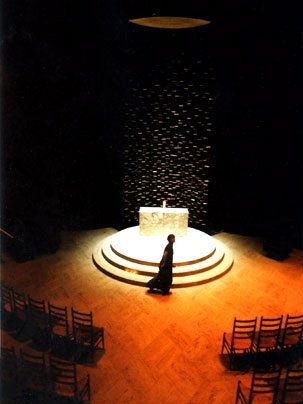Two once-controversial additions to MIT's evolving campus celebrate 50 years of service to the spiritual and creative life of the Institute community this year.
The MIT Chapel and Kresge Auditorium, both designed by Finnish-American architect Eero Saarinen, were dedicated in 1955 in a ceremony that included a performance of music commissioned for the event, Aaron Copland's "Canticle of Freedom."
At the time, Saarinen's MIT buildings brought the shock of the new to campus. Since then, both the chapel and Kresge Auditorium have been acknowledged as architectural landmarks.
"Saarinen was an architect of the geometric sublime. His MIT composition of straight lines and arcs has the simple yet awesome clarity of Euclid's great proof constructions. Fifty years after the construction of Kresge and the chapel, architects still make pilgrimages with their sketchbooks and cameras, and try to figure out how this master of mid-century modernism did so much with seemingly so little," said William Mitchell, professor of architecture and media arts and sciences and academic head of media arts and sciences.
The chapel, a brick cylinder stretching 33 feet into the air, topped with an aluminum bell tower and encircled by a shallow moat, was planned as an island of serenity, a space for contemplation and interfaith worship separated from the urban and academic campus.
Saarinen, who had designed furniture that was exhibited at the New York Museum of Modern Art and also created St. Louis' sleek, famous arch, "Gateway to the West," planned the MIT Chapel to project a "self-contained, inward-feeling environment," he wrote at the time.
To enhance this atmosphere of "spiritual unworldliness," Saarinen created undulating brick walls and low rounded windows that allow light reflected from the moat to play on the chapel's interior.
Saarinen was a "virtuoso of sunlight on surface; the interior of the chapel creates absolute magic from the soft glimmer of subtly shaded brick, and the interplay of glitter and gloom," Mitchell noted.
Inside the chapel, a delicate screen of rectangular metal "leaves" hangs behind a plain marble altar, enhancing the sense of light emanating from unseen sources. Harry Bertoia designed the screen.
The chapel's spire and bell tower, designed by sculptor Theodore Roszak, were added in 1956. The bell, also designed by Roszak, was cast at the MIT foundry, which was then located on the top floor of Building 35.
Roszak's drawings for the chapel's bell tower are on exhibit in The Dean's Gallery, Sloan School of Management, through Dec. 16.
The MIT Chapel is used for religious services, memorial services and concerts.
Kresge Auditorium, MIT's performance and rehearsal hall, is the chapel's fraternal - and far from identical - twin. Kresge's graceful roof, sheathed in copper, its triangular plan and its glass-and-steel windows contain a hive of activity. A little theater, a concert hall and rehearsal rooms within are used for everything from drama to dance to music performances, as well as symposia and science, technology and engineering conferences.
Saarinen's other landmark designs include New York's Kennedy and Washington's Dulles airports, whose terminal buildings resemble Kresge in their signature floating eyebrow-shaped entrances. These bright, aggressively modern public spaces still suggest how events in 1955 - the year that Rosa Parks refused to sit in the back of a Montgomery, Ala., bus; that fiber optics were developed; that the Warsaw Pact was signed; and Albert Einstein and James Dean died -- foreshadowed things to come.
A version of this article appeared in MIT Tech Talk on October 19, 2005 (download PDF).






